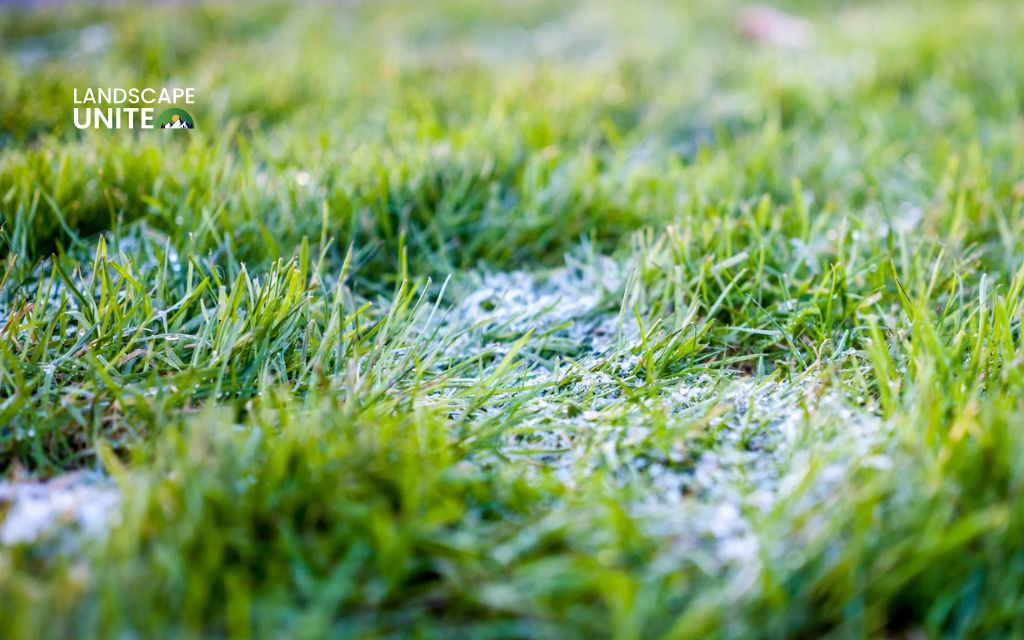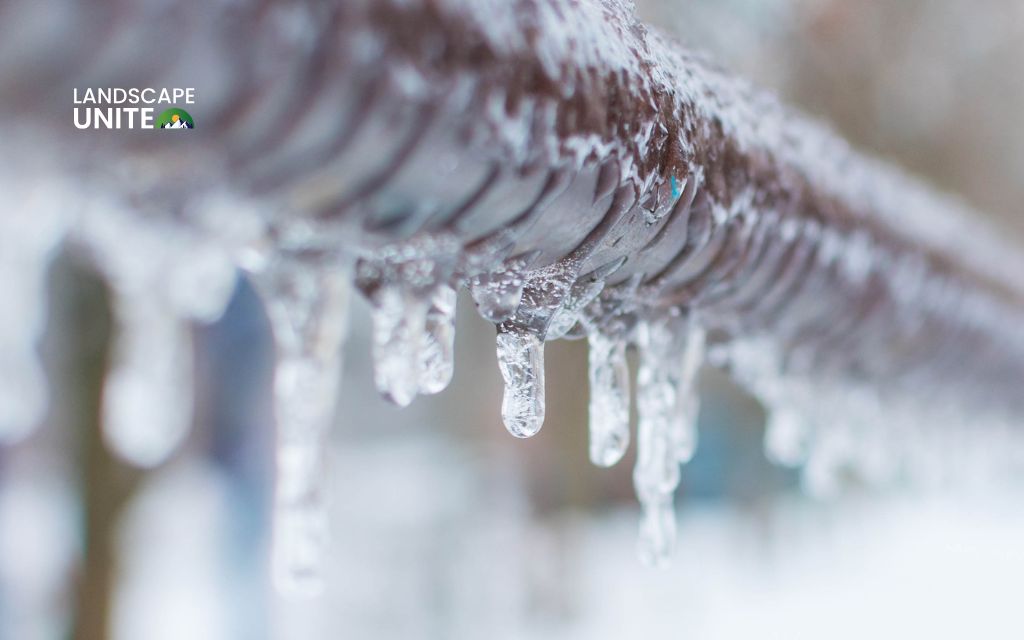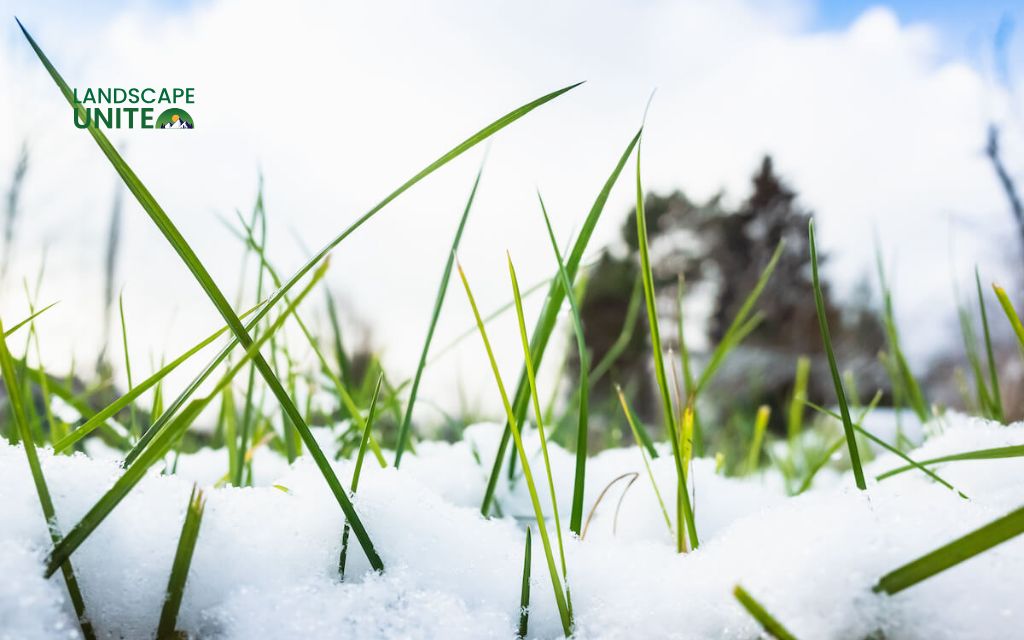Winter can be tough on lawns but with the right prep, yours can bounce back greener than ever come spring. No matter your grass type, winterizing your lawn protects it from damage and sets it up for a strong recovery.
This step-by-step guide breaks down exactly how to winterize lawn in 6 simple, practical steps that will keep your lawn healthy through the coldest months and ready for vibrant spring growth.

How to winterize lawn? Step-by-step guide
Yard cleanup
Rake fallen leaves to prevent suffocation – a thick layer of leaves blocks sunlight and traps moisture, creating perfect conditions for fungal diseases and pest problems.
Remove any debris, branches, or toys that could create dead spots or harbor pests during winter dormancy.
Your final mow of the season is crucial. Cut grass short to 2.5–3 inches to discourage winter fungus and reduce the risk of snow mold. This height prevents matting under snow while still providing enough blade length to protect the crown.
Aerate compacted soil
Compacted soil is your lawn’s worst enemy, especially heading into winter.
Core aeration reduces thatch buildup and improves nutrient uptake by creating channels for water, air, and nutrients to reach grass roots. Use a core aerator – either rent one for larger lawns or purchase a manual version for smaller areas.
The best practice is to aerate every 1–2 years for most lawns, though high-traffic areas may benefit from annual aeration.
Fall aeration is ideal because it gives grass time to recover before winter dormancy while allowing nutrients from your fall fertilizer to penetrate deeper into the root zone.
Apply the right fall fertilizer
Use a slow-release, high-potassium formula like 10-0-20, which strengthens cell walls and improves cold tolerance without promoting excessive top growth that’s vulnerable to frost damage.
- Cool-season grasses (fescue, bluegrass, ryegrass) should receive fall fertilizer to boost root reserves for winter survival. These grasses are actively growing in fall and can effectively utilize nutrients.
- Warm-season grasses (Bermuda, Zoysia, St. Augustine) need early fall fertilization only – fertilizing too late risks encouraging tender growth that frost will damage.
Avoid high-nitrogen fertilizers after October for most zones, as nitrogen promotes leaf growth that won’t survive cold temperatures.
Explore what fertilizers to use in the fall in this blog.
Overseed (cool-season grass only)
If you have cool-season grass, fall is the perfect time to overseed thin or bare spots.
The combination of warm soil temperatures and cooler air creates ideal germination conditions, while autumn moisture helps establish new seedlings before winter. Combine overseeding with aeration for optimal soil-to-seed contact and better germination rates.
After overseeding, water lightly and consistently for 2–3 weeks to ensure proper establishment. The new grass will develop strong roots during fall and be ready for vigorous spring growth.
Water properly
Lawns still need moisture during fall months, especially when rainfall is inadequate. Provide about 1 inch of water per week if natural precipitation falls short.
Fall watering is particularly important after aeration and overseeding, and it helps grass build carbohydrate reserves for winter survival.
Shut down irrigation systems
Before freezing temperatures arrive, properly drain and blow out sprinkler systems to prevent burst pipes and expensive spring repairs.
Even small amounts of trapped water can expand when frozen, cracking pipes, valves, and sprinkler heads. This step is non-negotiable in zones where temperatures drop below 32°F.
If you’re not comfortable performing irrigation system winterization yourself, hire a professional service. The cost of proper winterization is far less than repairing freeze damage in spring.

When should you winterize your lawn?
The best time to begin is when soil temperatures consistently drop below 55°F but before the ground freezes solid. This typically occurs during a sweet spot when grass is still active enough to benefit from your efforts but approaching dormancy.
- Cool-season lawns should be winterized from mid-September to late October, depending on your specific zone. These grasses remain active longer into fall and benefit from later fertilization and overseeding.
- Warm-season lawns require earlier attention, typically from late October to mid-November, since they enter dormancy sooner and need time to harden off before cold weather.
Why do you need to winterize your lawn?
Proper winterization is an investment that pays dividends come spring.
- Winter kill occurs when grass dies from cold injury, desiccation, or disease – problems that proper preparation can largely prevent. Compacted soil becomes even more problematic in winter when freeze-thaw cycles create additional stress on grass roots.
- Fungus issues like snow mold thrive under the perfect storm of moisture, darkness, and cool temperatures that winter provides. By removing leaves, adjusting mowing height, and improving air circulation through aeration, you create conditions that discourage fungal problems.
- The biggest reward comes in spring when properly winterized lawns green up faster, grow more vigorously, and require fewer inputs to look their best.
You’ll save money on repairs, reseeding, and irrigation issues while enjoying a healthier, more resilient lawn that better withstands summer stress.

Common mistakes to avoid
- Fertilizing too late: Fertilizing too late is perhaps the most common winterization mistake. Late-season nitrogen applications encourage tender growth that frost will damage, actually weakening your lawn rather than strengthening it.
- Cutting grass too short or leaving it too long: Scalping exposes crowns to cold injury, while excessively long grass mats under snow and invites disease. The 2.5 – 3 inch sweet spot provides optimal protection while minimizing disease risk.
- Skipping aeration year after year: This leads to increasingly compacted soil that struggles to support healthy grass. Even if your lawn looks acceptable, compacted soil limits root development and makes grass more vulnerable to stress.
- Forgetting to clean up leaves might seem harmless, but thick leaf layers can literally smother grass and create ideal conditions for pest and disease problems.
Conclusion
Winter lawn care isn’t just about surviving – it’s about setting the stage for spring success. With the right preparation, your lawn will come back greener, thicker, and healthier than ever. These 6 essential steps provide a roadmap for protecting your investment and ensuring vibrant spring recovery.
Remember that successful winterization is about understanding your specific grass type, climate zone, and timing. Take the time to do it right, and you’ll be rewarded with a lawn that’s the envy of your neighborhood come spring. Discover additional lawn care tips for every season in our extensive gardening resource center.
Discover other fall garden care guides from our blog:
6 Key steps to prepare your plants for winter
How late in the fall can you mow without harming your lawn?
What is the recommended lawn mowing height for fall?
Frequently asked questions (FAQs)
How should I prepare my grass for winter?
Focus on the 6 key steps: clean up debris and leaves, aerate compacted areas, apply appropriate fall fertilizer, overseed thin spots (cool-season grass only), maintain proper watering through fall, and winterize irrigation systems.
What’s the best fertilizer for winterizing lawns?
Use a slow-release, high-potassium fertilizer with minimal nitrogen, such as a 10-0-20 formula. Potassium strengthens cell walls and improves cold tolerance. Look for products specifically labeled as “winterizer” fertilizers, which are formulated for fall application and winter protection.
Do I still need to mow before winter?
Yes, your final mow is crucial. Cut grass to 2.5–3 inches to prevent matting under snow while providing adequate crown protection. This height discourages fungal diseases like snow mold while making spring cleanup easier.
Should I apply lime or compost in fall?
Fall is an excellent time for both amendments. Apply lime if a soil test indicates pH needs adjustment – lime works slowly and fall application gives it time to modify soil chemistry before spring growth. Compost topdressing after aeration adds organic matter and improves soil structure over winter.


